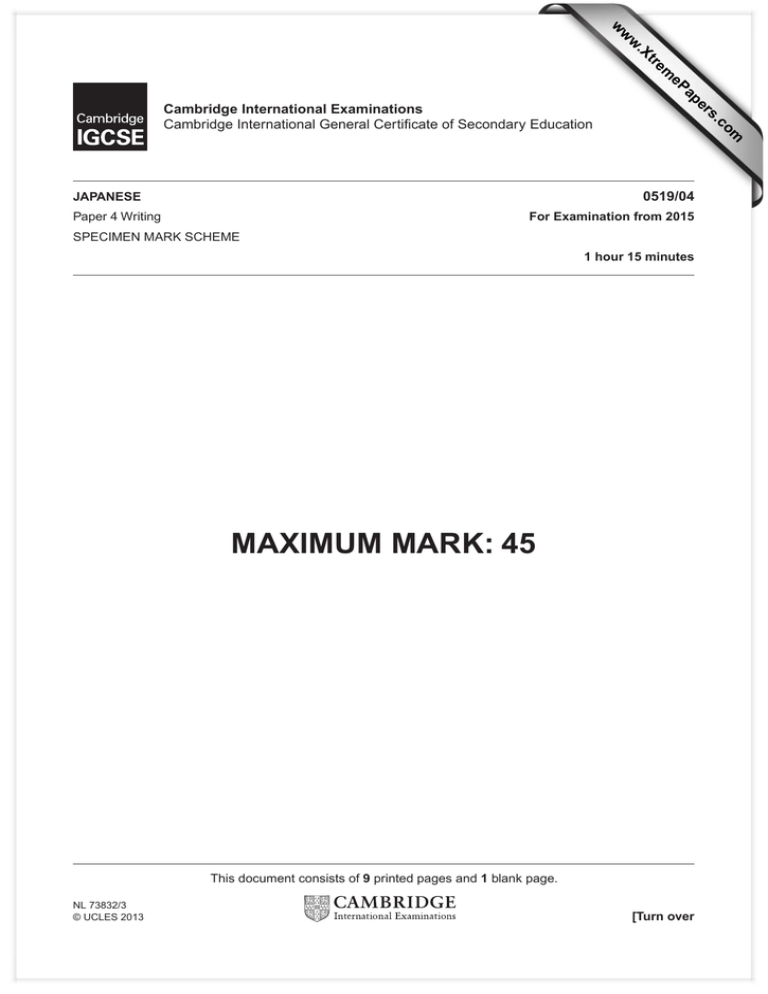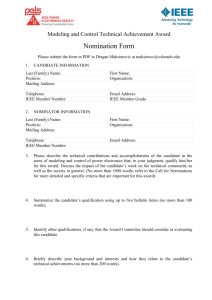MAXIMUM MARK: 45 www.XtremePapers.com Cambridge International Examinations 0519/04
advertisement

w w ap eP m e tr .X w om .c s er Cambridge International Examinations Cambridge International General Certificate of Secondary Education 0519/04 JAPANESE Paper 4 Writing For Examination from 2015 SPECIMEN MARK SCHEME 1 hour 15 minutes MAXIMUM MARK: 45 This document consists of 9 printed pages and 1 blank page. NL 73832/3 © UCLES 2013 [Turn over 2 SECTION 1 Question 1 Candidates are required to list 8 items in Japanese. Read all the items the candidate has listed and award marks as follows: • • Selectthemostcorrectitemsuptoamaximumof5 Award1markforeachcorrectitemuptoamaximumof5 NB the pictures provided on the question paper are only suggestions. Accept any item the candidate could take to their grandparents’ house. Generic mark scheme for Question 1 • nswers should be marked for communication. Tolerate inaccuracies, provided the message is A clear. a) b) ‘If in doubt, sound it out’: if you read what the candidate has written, does it sound like the correct answer? Look-alike test: does what the candidate has written look like the correct answer? Session-specific instructions for Question 1: things you might take when you go to stay at your grandparents’ house. • The following are examples. Accept anything the candidate might take to their grandparents. ACCEPT けいたい電話 本 バッグ 食べもの 花 MP3プレーヤー したぎ セーター ようふく おみやげ おこずかい TotalforQuestion1:5marks © UCLES 2013 0519/04/SM/15 3 Question 2 Candidates are required to answer the question. Read the whole answer and award marks as follows: • • Communication:awardamarkoutof10,accordingtotheinstructionsin2.1 Language:awardamarkoutof5,accordingtotheinstructionsin2.2. 2.1:awardamarkoutof10forCommunication Generic mark scheme for Communication (Question 2) (i) (ii) (iii) (iv) (v) (vi) (vii) (viii) (ix) Place the appropriate ‘numbered’ tick as close as possible to each relevant communication point. Award ticks flexibly across the tasks for each piece of relevant information conveyed up to a maximum of 10. HOWEVER, each of the 4 tasks must be covered to get the 10 communication marks: • If 1 of the tasks is missing, the maximum communication mark is 9. • If 2 of the tasks are missing, the maximum communication mark is 8 (and so on). Add up the ticks to give a mark out of 10 for Communication. For COMMUNICATION, be tolerant of time frames and minor hiragana, katakana and kanji errors, provided they are written clearly enough to be understood. LISTS = a maximum of 3 marks for communication: lists of 1–3 items = 1 mark; lists of 4 items = 2 marks; lists of 5–6 items = 3 marks Only reward each piece of information once, e.g. «she is nice» cannot score both as description and reason for liking («she is nice» and «her music is great» can both be rewarded). Up to 4 further marks available for additional details for (a), (b), (c) or (d) 1 mark available for appropriate beginning or ending, e.g. 私が好きな有名人は xxx です。/ だから xxx が大好きです。 Do not penalise factual errors. TotalmarksforCommunication:10 Session-specific instructions for Communication marks (Question 2): あなたが 好きな 有名人について 書いてください。 Tick 1 2 3 4 Accept Name = 1 mark; profession = 1 mark. As long as either given, consider task complete REWARD: any form of description: e.g. anythingabouttheperson – appearance, character, age, more detail about what they do, family background, likes/dislikes, etc. REWARD: a positive comment, even if ‘like’ is not stated ACCEPT: ‘yes’ or ‘no’ or ‘don’t know’ and/or what they are going to do as a job ACCEPT: reason why/why not, even if not clear whether or not they would do same job/ what job they would do © UCLES 2013 0519/04/SM/15 [Turn over 4 2.2:awardamarkoutof5forAccuracyofLanguage Generic mark scheme for Language (Question 2): • Awardamarkoutof5forLanguageaccordingtotheGradedescriptorsinthetablebelow (see Note on using mark schemes with Grade descriptors (last page of mark scheme)): GradedescriptorsforLanguage(Question2) 5 4 3 2 1 0 Highly accurate in the use of simpler structures, with occasional minor slips. Accurate in the use of simpler structures, except for occasional more serious errors/ more frequent slips. Generally accurate, but with increased incidence of more serious errors. Substantially inaccurate, despite several examples of accurate usage. Substantially inaccurate, with only isolated examples of accurate usage. No examples of accurate usage. TotalmarksforLanguage:5 TotalforQuestion2:15marks © UCLES 2013 0519/04/SM/15 5 SECTION 2 Question 3 Candidates answer 1 question from a choice of 3. Read the whole answer and award marks as follows: • • Communication:awardamarkoutof5,accordingtotheinstructionsin3.1 Language:awardamarkoutof5forAccuracyofCharacters,accordingtothe instructionsin3.2 awardamarkoutof10forAccuracyofGrammarandStructures,according totheinstructionsin3.3 awardanImpressionmarkoutof5,accordingtotheinstructionsin3.4. 3.1–awardamarkoutof5forCommunication Generic mark scheme for Communication (Question 3): (i) There are 5 relevant communication points per question, each worth a maximum of 1 mark. (ii) For each relevant communication point, use the appropriate numbered tick and place 1 of these ticks as close as possible to each relevant communication point. (iii) Add up the ticks to give a mark out of 5 for Communication. TotalmarksforCommunication:5 © UCLES 2013 0519/04/SM/15 [Turn over 6 Session-specific instructions for Communication marks (Question 3): • Question 3(a): letter to a friend about your birthday party Tick 1 2 3 4 5 • Accept Whatthepartywaslikeandwhowasthere Allow any description. Must include who was there Whatcandidatelikesaboutbirthdaysandwhy Allow anything sensible Howdidthecandidatefeelaftertheparty Expect feelings/reactions Whatthecandidatewantstodonextbirthday Award communication mark for statement in future time frame of what candidate wants to do next birthday Appropriatebeginningorendingtoletter The letter must also include the name of the person to whom it is being sent at the beginning, or the name of the person sending it at the end of the letter for the communication mark to be awarded Mark 1 1 1 1 1 Question 3(b): the country you live in Tick 1 2 3 4 5 • Accept Whatthecountrythecandidatelivesinisfamousfor Allow anything sensible Wherecandidatehasbeenrecently Insist on past time frame Whycandidateenjoyedvisitingtheplace Allow anything sensible Whycandidatethinkstouristsshouldvisittheircountry Allow anything sensible Appropriateelaborationofoneofthebulletpoints Final communication mark to be awarded flexibly for extra detail relating to any of the first four bullet points in the question. Mark 1 1 1 1 1 Question 3(c): my mum was driving me to the train station when the car started to make a strange noise… (continuation of a story) Tick 1 2 3 4 5 Accept Whatcandidatedid Award communication mark for statement in past time frame of what candidate did on hearing the strange noise Whatcandidate’smumdid Award communication mark for statement in past time frame of what candidate’s mum did on hearing the strange noise Wherecandidatewasgoing Award communication mark for statement of where candidate was going by train Whythecandidatewasgoingthere Award communication mark for statement of why candidate had to catch the train Reactiontotheday Expect opinions/emotions. Do not insist on past time frames © UCLES 2013 0519/04/SM/15 Mark 1 1 1 1 1 7 3.2–awardamarkoutof5forAccuracyofCharacters Generic mark scheme for Accuracy of Characters (Question 3): • Awardamarkoutof5forAccuracyofCharactersaccordingtotheGradedescriptorsinthe table below: GradedescriptorsforAccuracyofCharacters(Question3) 5 4 3 2 1 0 Highly accurate, with a wide range of characters including some more difficult or unusual ones correctly written, with occasional minor slips. A good range of characters attempted with easy and moderately easy characters correctly written. Limited range, but with most easy characters correctly written (or a wide range with a lot of errors). A number of examples of easy characters correctly written. Substantially inaccurate, with only isolated examples of correctly written characters. No examples of correctly written characters. TotalmarksforAccuracyofCharacters:5 3.3–awardamarkoutof10forAccuracyofGrammarandStructures Generic mark scheme for Accuracy of Grammar and Structures (Question 3): • Award a mark out of 10 for Accuracy of Grammar and Structures according to the Grade descriptors in the table below: GradedescriptorsforAccuracyofGrammarandStructures(Question3) 10/9 8/7 6/5 4/3 2/1 0 Highly accurate including use of more complex structures, but with occasional minor slips. A little more ambitious than the 6/5 band. Accurate in the use of simple structures, except for occasional more serious errors/more frequent slips. Limited in range, but displays some control of simple structures. Inconsistent, but a number of examples of accurate usage. Substantially inaccurate, with only isolated examples of accurate usage. No examples of accurate usage. TotalmarksforAccuracyofGrammarandStructures:10 © UCLES 2013 0519/04/SM/15 [Turn over 8 3.4–awardamarkoutof5forImpression Award a mark out of 5 for Impression according to the conversion table below. The pro rata mark based on the Accuracy mark should serve as the first guide. This mark should be adjusted up or down by one mark where this is justified by the candidate’s use of idiom, vocabulary and structures. ConversionTableforImpression(Question3) Markoutof15 (forAccuracyofLanguage) Prorata(Impression) Max 5 15 5 14 5 13 4 12 4 11 4 10 3 9 3 8 2 7 2 6 2 5 1 4 1 3 1 2 0 1 0 0 0 TotalmarkforImpression:5 TotalforQuestion3:25marks © UCLES 2013 0519/04/SM/15 9 NoteonusingmarkschemeswithGradedescriptors It is important that you award marks positively. In order to ensure that you reward achievement rather than penalise failure or omissions, you should start at the bottom of the mark scheme and work upwards through the descriptors when awarding marks. You should adopt a ‘best fit’ approach. You must select the set of descriptors provided in the mark scheme that most closely describes the quality of the work being marked. As you work upwards through the mark scheme, you will eventually arrive at a set of descriptors that fits the candidate’s performance. When you reach this point, you should always then check the descriptors in the band above to confirm whether or not there is just enough evidence to award a mark in the higher band. For example, when marking Question 3 you may find that a candidate uses a variety of relevant vocabulary but has varied success with more complex structures. In such cases, you will need to award a mark that takes into account both the strengths and weaknesses of the piece of work. To select the most appropriate mark within each set of descriptors, use the following guidance: • • Ifmostofthedescriptorsfitthepiece(andafteryouhaveconsideredthebandabove),awardthe top mark in the band. Ifthereisjustenoughevidence(andyouhadperhapsbeenconsideringthebandbelow),award the lowest mark in the band. Note on irrelevant material In the case of a deliberately evasive answer which consists entirely of irrelevant material exploited in defiance of the rubric, a score of 0 is given. These are extremely rare. The genuine attempt to answer the question which fails due to a misunderstanding of the rubric will normally lose Communication marks but will score for Language. You should consult your Team Leader. When part of an answer is clearly irrelevant, highlight it and do not consider it when deciding on the Language mark. (e.g. Highlight and do not consider for Language an introduction to a question consisting of an unwanted self-portrait on the lines of: 「こんにちは。私の名前はXです。十六才で す。Xに住んでいます。」 or letter etiquette where a letter is not required.) © UCLES 2013 0519/04/SM/15 10 BLANK PAGE © UCLES 2013 0519/04/SM/15



